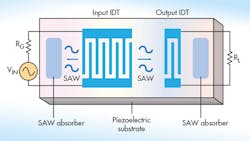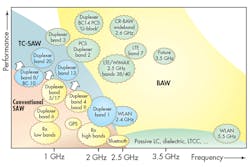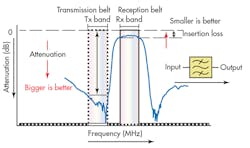Portable Wireless Products Drive Filter Miniaturization
This file type includes high resolution graphics and schematics when applicable.
The arrival of new wireless standards and their narrowly spaced channels has filter manufacturers scrambling to enhance the performance and footprint of high-quality-factor (high-Q) surface-mount filter technologies. These performance requirements push the limits of discrete, surface-acoustic-wave (SAW), and bulk-acoustic-wave (BAW) filters, forcing filter manufacturers to look to other technologies to meet the needs of handset providers. In pursuit of advanced filter technologies, manufacturers are developing enhanced temperature-coefficient SAW/BAW devices, complete CMOS RF front-end solutions, and RF microelectromechanical-system (MEMS) filters.
Fourth-generation (4G) Long Term Evolution (LTE) wireless systems alone have 20 frequency-division-duplex (FDD) bands, with another seven time-division-duplex (TDD) bands. The LTE bands range from 0.7 to beyond 2.6 GHz—a very wide range for a single-filter technology to meet all necessary performance criteria. Various IEEE 802.11 standards, including 802.11ac/af/ad/ah, are also adopting under-1-GHz frequencies, as well as higher frequencies into the millimeter-wave ranges. Compact filter solutions that cover the large number of frequency bands in these wireless systems simply aren’t feasible with discrete filter technologies.
Moreover, recent modifications to LTE and Wi-Fi standards incorporate carrier-aggregation (CA) and multiple-input, multiple-output (MIMO) techniques to enhance data rates with the limited and narrowly packed spectrum resources available. Though CA and MIMO are promising options to boost data rates, these techniques also increase the isolation and out-of-band rejection requirements of the filters. In addition, MIMO systems will require reduced reflections, reduced insertion loss, and enhanced tunability of each additional filter system for each antenna in the MIMO configuration
SAW, BAW Temperature Over-Compensation
These wireless-system constraints leave surface-mount-packaged or die-level solutions as the apparent viable options. Unfortunately, silicon filters tend to exhibit very low Qs, and the size constraints of capacitive and inductive circuit elements limit lower-frequency silicon-filter performance.
As a result, handset manufacturers today most often turn to SAW and BAW filters. SAW filters tend to operate well at lower frequencies and are more cost-effective than other filter technologies. BAW filters can perform with extremely high Qs at higher frequencies and occupy much smaller packages over SAW devices. However, both SAW and BAW filters suffer from relatively unstable temperature performance, since the material properties of the resonant structures change significantly with temperature.
Qorvo recently released SAW and BAW devices with temperature coefficients below –20 and –17 ppm/ºC, respectively. Enhanced versions of Qorvo’s new BAW and SAW filters can also reach temperature coefficients as tight as –1 and –2.5 ppm/ºC, respectively.
Although they represent promising technologies, the filters tend to be a few millimeters on a side and are designed for wireless infrastructure and repeater markets rather than for portable wireless products (e.g., handsets). Also, tunability functions with filter technologies are being used to replace several filters with a single tunable element. This aspect requires a highly integrated filter device, which can be quite a challenge with BAW and SAW fabrication methods.
RF SOI Integrated Solutions
One benefit of RF silicon-on-insulator (SOI) technology is enhanced performance, compared to traditional silicon, for RF/microwave frequency use. On the other hand, though, it’s rather difficult to develop a cost-effective method that makes silicon circuits behave well at higher frequencies and with reliable performance. But, by means of CMOS integration and advanced digital control, the benefits of operating on common CMOS fabrication platforms can outweigh material limitations.
Aiming for the highly integrated and advanced control approach, Peregrine/Murata introduced a complete 3G/4G LTE RF-SOI front-end with tunable power amplifiers (PAs), PA switches, filter banks, and antenna switches based on its UltraCMOS Global 1 technology. With a tunable PA for low-, mid-, and high-band use and selectable filters, a reconfigurable RF front-end can cover the three 3G/4G LTE frequency ranges.
Even though UltraCMOS Global 1 technology isn’t a solution for the handset market, the movement toward implementing a highly integrated system with switching elements and filters may be a promising track for RF SOI use in handsets in the future.
RF MEMS Switches and Filters
The concept of integrating switches and filters using a silicon CMOS process isn’t solely targeted at RF SOI. In the case of RF MEMS, this technology has the potential to incorporate switches and high-Q filter elements in extremely small packages. Tunable elements can also be included in many RF MEMS solutions, leading to reconfigurable switch and filter technologies that may even be able to tackle CA and MIMO bandwidth and filter performance demands.
Following this trend, DelfMEMs developed a MEMS solution with highly compact ohmic switches, with as many as 12 switch throws. Although still in the research and development phase, MEMS tunable-filter elements will most likely be realizable within the next few years at reasonable cost. With the increased number and proximity of wireless bands, RF MEMS filters may become viable front-end components for mass-manufactured handsets.
Cascadable Absorptive Filter Technology
Using passive gallium-arsenide (GaAs) technology, the National Radio Astronomy Observatory (NRAO) developed a filter technology with extremely low reflections that can operate from dc to 40 GHz. Mini-Circuits recently licensed NRAO’s filter technology, which has the potential to deliver a low-reflection and temperature-stable filter technology with a return loss of less than 20 dB and in-band insertion loss under 0.5 dB.
In this technology, a single filter typically measures 1 × 1 mm on a die. As many as four filters can be cascaded and housed in a QFN package measuring 6 × 6 mm, according to NRAO. While cascading filters does inflate in-band insertion loss, stop-band attenuation also increases with a greater number of cascaded filters. A four-filter package can produce greater than 50 dB of attenuation at a frequency of interest.
Placing absorptive filters within a RF signal chain doesn’t carry any major concern regarding reflected energy adversely affecting sensitive components or nonlinear components. In a highly integrated environment, this could lead to very tight packing of filter, switch, and transmitter/receiver elements for a more optimal footprint reduction.
Although advances in SAW and BAW filters may fulfill current demands for performance and physical size, future wireless standards will require greater tunability and smaller package sizes. RF SOI solutions achieve the highly integrated and tunable aspects of future wireless standards. Unfortunately, RF SOI filter solutions aren’t yet cost-effective and reconfigurable enough for mobile handsets and multiple wireless standards. In addition, RF SOI technology may require more development before CMOS filter Q factors can reach the levels of BAW and SAW devices.
RF MEMS technology researchers recently demonstrated the ability to produce high-performance filters and switches in compact packages that operate over a wide bandwidth. Though only RF MEMS switch components are currently available on the market, RF MEMS filters and tunable integrated RF MEMS modules should be viable in time to meet high-bandwidth CA and MIMO wireless demands.
Moreover, other innovative filter integration technologies are solving other aspects of high-performance and sensitive RF component placement on a single die. NRAO’s cascaded filters have the potential to reduce on-chip element counts significantly by intrinsically reducing reflections from the filter components without the need for additional attenuators.
This file type includes high resolution graphics and schematics when applicable.
Many recent technological developments are nearing viability in the high-volume/low-cost mobile handset market. These technologies embrace configurations that can cover low RF frequencies to millimeter-wave frequencies in extremely compact packages.
RESOURCES:
SAW Filters Rescue Wireless Products from Impractical Discrete Implementations
National Radio Astronomy ObservatoryReflectionless Filters
About the Author
Jean-Jacques DeLisle
Jean-Jacques graduated from the Rochester Institute of Technology, where he completed his Master of Science in Electrical Engineering. In his studies, Jean-Jacques focused on Control Systems Design, Mixed-Signal IC Design, and RF Design. His research focus was in smart-sensor platform design for RF connector applications for the telecommunications industry. During his research, Jean-Jacques developed a passion for the field of RF/microwaves and expanded his knowledge by doing R&D for the telecommunications industry.




